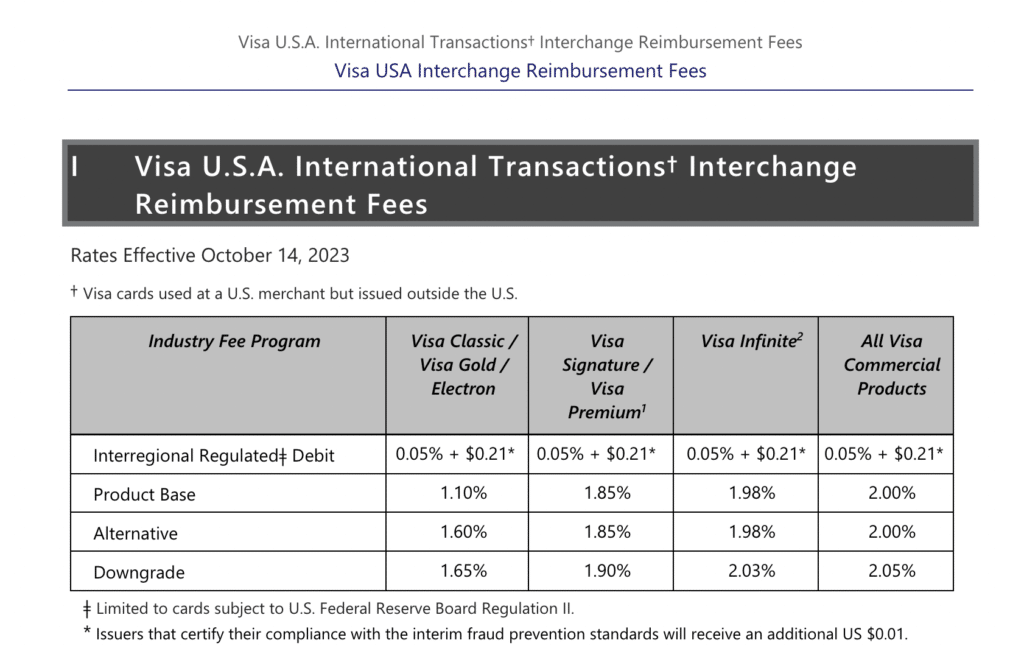Wondering why some Visa transactions are more expensive to process than others? There are lots of different factors that impact your Visa interchange rates—including the specific type of Visa card and the transaction environment.
But if you see Visa ISA or just ISA Fee as a line item on your monthly processing statement, you’ll likely see it billed at a separate rate than your other Visa transactions for the cycle.
Is this fee legit? Do you need to pay for it? Is your processor ripping you off?
Read on to find out.
What is the Visa ISA Fee?
The Visa ISA Fee is an International Service Assessment Fee. Like other assessment fees, it’s charged at the card network level (in this case, by Visa), and passed through the processor to the merchant.
If a customer pays for something using a Visa-branded credit card or debit card that was issued by a bank outside of the US, those transactions will be assessed with the ISA Fee.
Visa first introduced the ISA Fee back in 2008 as a way to cover the higher risks and costs associated with international transactions.
How Much is the Visa ISA (International Service Assessment) Fee?
Visa’s ISA Fee ranges from 0.30% to 2.30%, and the exact rate varies based on where the cardholder’s issuing bank is located. For US-based merchants accepting foreign credit cards, we typically see Visa assess these transactions at 0.80% to 1.20%.
It’s also worth noting that the assessment rate varies based on which currency the transaction gets settled in.
For example, let’s say a US merchant processes a credit card that was issued in Europe. If the cardholder is a tourist visiting the United States and the transaction is settled in USD, then the fee will be on the lower end of the spectrum—and will likely be charged an ISA Fee of 0.80%. But if the cardholder purchases something online and decides to settle the transaction in EUR, then the fee will be higher. The currency conversion cost will bump that fee up to 1.20%
Here’s something else you need to realize. The Visa ISA Fee is charged in addition to the interchange fee.
Let’s take a look at some potential interchange categories that Visa uses for international transactions:
As you can see from the table, some of these transactions could have an interchange fee as high as 2.05%. The ISA Fee gets added to this, which means accepting an international card could cost you upwards of 3.25% before you factor in any of the markups and fees imposed by your processor.
Who Pays ISA Fees For International Visa Transactions?
Merchants are responsible for paying the Visa ISA Fee, and there’s really not much that can be done about it.
The business essentially pays for the cardholder’s convenience for using a Visa card that was issued by a bank in their home country. Visa could charge the customer for this, but they don’t. Even if a particular Visa card doesn’t offer free foreign transactions to the cardholder, that arrangement is completely separate and has nothing to do with the ISA Fee billed to the merchant.
This is all tied to the relationships between the issuing bank (the cardholder’s bank in another country) and the acquiring bank (the merchant’s bank, located domestically).
Additional Reading: Issuing Banks vs. Acquiring Banks in Credit Card Processing
The nature of this relationship and the transfer of funds between accounts results in higher fees for Visa, so those fees are passed along to the merchant. Furthermore, cross-border transactions can be riskier in terms of fraud and chargebacks—again, making things more expensive for Visa.
So they add this fee to cover themselves, and the ISA Fee isn’t the only Visa assessment for international transactions.
ISA Fee vs. IAF Fee
In addition to the ISA Fee, Visa also charges an IAF Fee (International Acquirer Fee) on all cross-border transactions.
Visa IAF Fee is 0.45% per international transaction—which means between the interchange rate and these two assessments (ISA + IAF), Visa can collect nearly 4% in fees.
There’s really no major difference between the ISA Fee and IAF Fee because both are triggered for the exact same circumstances. If a transaction qualifies for one, then it automatically qualifies for the other.
It’s really just semantics saying that one of the fees is a “service” fee and the other is an “acquiring” fee.
Other International Service Fees For Foreign Transactions
Visa isn’t the card network that charges merchants extra for accepting cards issued in another country. Here’s a look at international service fees you’ll see from the other card networks:
- Mastercard Cross Border Fee: 0.40%
- Mastercard Acquirer Program Support Fee (APSF): 0.55%
- American Express Cross-Border Fee: 0.40%
- Discover International Processing Fee: 0.55%
- Discover International Service Fee: 0.80%
Final Thoughts: How to Save Money When Processing International Credit Cards
Visa’s ISA Fee is virtually unavoidable. If you’re a US-based merchant that accepts Visa, you’re not going to be screening customers prior to checkout asking if their card was issued in another country. And if you attempt something like this, Visa will quickly revoke your right to accept their cards altogether.
One thing you can do to lower your international service assessments is to ensure that all online orders are settled in USD. Don’t give your customers in other countries the option to pay in their local currency.
When you factor in the interchange rates, assessments, and processor markups, most merchants in the US can expect to pay around 4% for international transactions—which is high.
Depending on the type of business you run, you might only encounter these transactions a handful of times per year. It’s obviously not ideal, but it shouldn’t be too concerning for you.
And while there’s nothing you can do about the interchange fees and assessments imposed by the card networks, you can do something about the fees charged by your processor.
Those rates are 100% negotiable, and it’s something you can take steps to reduce at any time. With the right negotiation tactics, you could cut that 4% down to 3.5% or potentially lower—saving you thousands on fees.
If you think your processing fees are too high, contact our team here at MCC for a free audit. We’ll let you know if you’re overpaying and what can be done to reduce your rates. We’ll even negotiate with your provider on your behalf so you can save money without switching processors.

